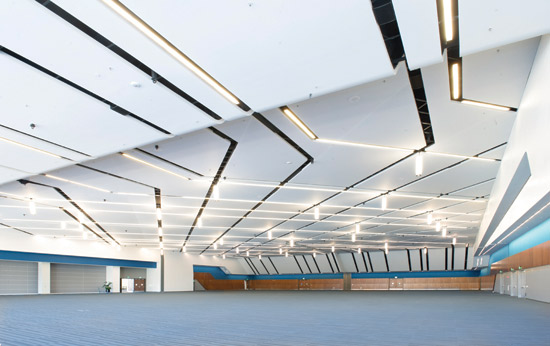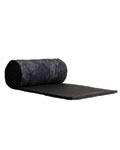Total Acoustical Design
By paying attention to all of the details of wall construction from an acoustical perspective, it is possible to raise the STC rating of interior walls from the low 30s up to STC 57 or higher which is a notable improvement. Similar performance levels in OITC can be achieved in solid exterior walls using these techniques too, although total performance there will also need to address windows, doors, and other openings.
Higher Sound Design: Ceilings and Floors
Sound can be transmitted through ceilings and floors just as easily as through walls. At the basic level, sound can be attenuated in a manner similar to walls by adding sound absorptive insulation in ceiling and floor systems. Some is designed specifically for use over suspended ceiling panels to economically improve both noise control and possibly thermal performance in new or existing ceiling systems. When placed on top of a suspended ceiling at a floor-to-ceiling partition, this type of insulation has been shown to help reduce the transfer of sound over the partition between rooms. As such it can improve the Ceiling Attenuation Class (CAC) rating by 4-10 points.

Photo courtesy of Owens Corning
Ceilings can be designed to achieve high acoustical performance using a variety of quality materials while also contributing significantly to the overall aesthetic of interior spaces.
For ceilings that are open to a metal structure or have a suspended metal ceiling, a different type of sound insulation may be appropriate. Acoustic sound blankets are available made of a variety of fibers and commonly with a black mat surface. Hence, it is excellent for eliminating light reflections while providing superior acoustical sound absorption to reduce sound transfer through the ceiling structure.
In multi-story buildings, the ceilings are also a floor for the story above. The measures described above, along with appropriate sealing, will still work very effectively in these cases for airborne sound. However the sound transmitted due to impacts need to be addressed differently. In this case, a material is needed to reduce the transmission of sound from people walking, dropping things, or operational activities. In some cases, the flooring itself can help reduce sound such as carpeting or cushioned vinyl flooring. However, that typically isn't enough to address areas with a fair bit of activity. Rather, the most effective approach is to install a continuous layer of material with a high Impact Insulation Class (IIC) rating between the subfloor and the finish flooring. Floor matting of this type is commonly composed of closed cell, extruded polyethylene foam or ethylene propylene diene monomer (EPDM). It is acoustically engineered to reduce structure-borne sound by isolating it to the room in which it is created. By placing it between the subfloor and then installing a plywood or gypsum concrete layer on top, it creates a continuous layer to isolate impacts, dissipating some energy and reflecting the remainder back into the space above. The installed plywood or gypsum concrete layer “floats” on top of the floor mat, thus providing a rigid surface for the finished flooring. The performance of these materials is dependent on the stiffness of the material and the weight of the over-layer and flooring above. Stiffer underlayment materials are needed as weight above increases.
Sound Specialties
Certain building conditions have special acoustic needs since they are subject to unique or specific sound conditions. Recognizing these needs and addressing them head on will allow for a truly comprehensive solution to good acoustic performance in buildings.
HVAC Ductwork
From an acoustical standpoint, ductwork is a wall or ceiling penetration that has the potential to bring noise into a space. That noise can come from the velocity of air movement or the design of the register such that those things should be appropriately addressed by the design professional overseeing the HVAC system. Nonetheless, ductwork may still be a conduit of other noise that needs to be controlled. The choices in this case are to add sound insulation in the ductwork leading into a space or to make the ductwork itself out of sound absorbing material.
Duct liner made from fiberglass or other sound deadening material offers noise-reducing and possible energy-saving benefits. Acoustically, duct liner is efficient at absorbing sound in the duct system and can achieve an NRC rating as high as 1.00, or completely sound absorptive under the right conditions. Some duct board products go further by creating an airtight seal within the duct which further helps to reduce noise transmission and energy leakage through the duct system. Some even feature a durable airstream smooth surface to avoid airflow resistance, help prevent fungus growth, and enable easy cleaning. These additional benefits may desirable, but they should be balanced with sound absorption rates and cost for this type of product. Fiberglass liner and duct materials possess a significantly higher sound absorption rate than these materials in comparable thicknesses and cost notably less.
High-Performance Spaces
Certain specialty spaces such as sound and music studios require particular attention to acoustical design since they often require only pure generated sound to be heard. Understanding the principles described in this article and using available materials, it is quite possible to design a room that has zero reverberation and 100% sound absorption. First, all of the available techniques to acoustically isolate all sides of space from any background noise including the walls, floor, and ceiling must be undertaken. In the case of acoustic test facilities and specialty studios, rooms are constructed completely isolated from other construction in the building.
Next, the walls, ceiling, and perhaps the floor need to be treated with appropriate sound-absorbing material. Black acoustic materials composed of inorganic fibers (i.e. fiberglass or mineral wool) or absorptive foam are common since they provide excellent sound absorption and very high NRC ratings; however foam does not usually perform as well per inch of thickness compared to fibrous materials. Properly using these materials will help provide the highest quality audio reproduction by reducing or eliminating any sound reverberation within the space. They will absorb up to 100% of the sound striking its surface depending on the specified thickness. Most of these materials are also dimensionally stable, will not shrink, warp, rot or mildew, and are noncorrosive to metals that may be used for sound recording equipment.
Conclusion
Architects and designers are well served when they take time in the design process to consider the acoustical needs of the building. Addressing the entire spectrum of sound control within individual rooms and spaces in a holistic or comprehensive manner will assure the best performance. By addressing the sound absorption, reflection, and reverberation time in a given room, the appropriate sound qualities can become part of a successful acoustic design. The multiple options available for materials and finishes allow architects and interior designers to retain control of the visual appearance of the walls, ceilings, and other surfaces. Further, by addressing the control of sound between spaces through walls, ceilings, floors, and specialty areas, each room can be appropriately shielded from background noise, unwanted sounds, and loss of privacy. Overall, this holistic, coordinated approach will yield a design that creates a very positive contribution to the total indoor environmental experience of the building.
Peter J. Arsenault, FAIA, NCARB, LEED AP, is a nationally known architect, sustainability consultant, technical writer, and continuing education presenter. www.linkedin.com/in/pjaarch
 |
 |
Notice

www.ceilingsplus.com

OCBuildingSpec.com

rulonco.com








